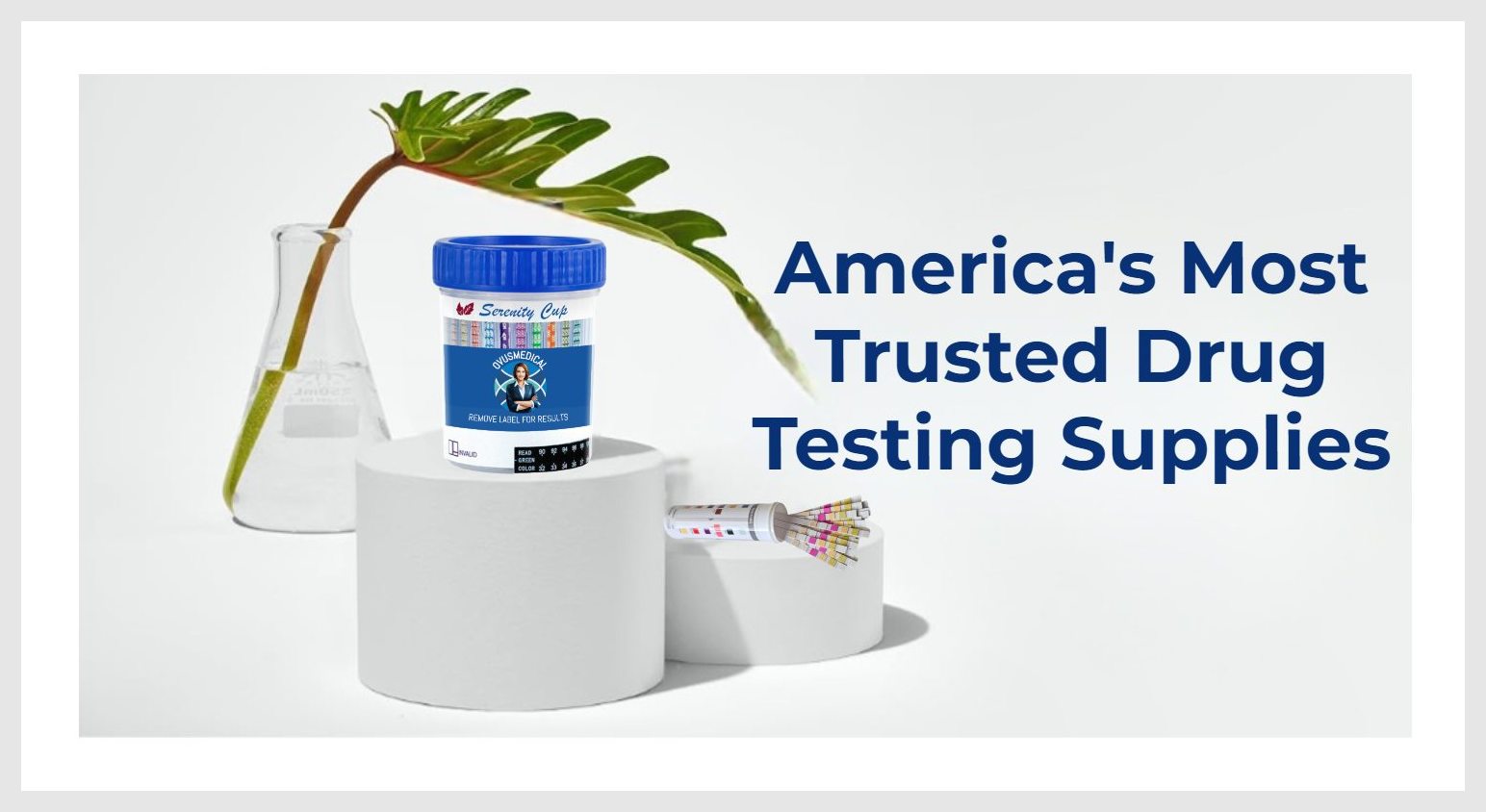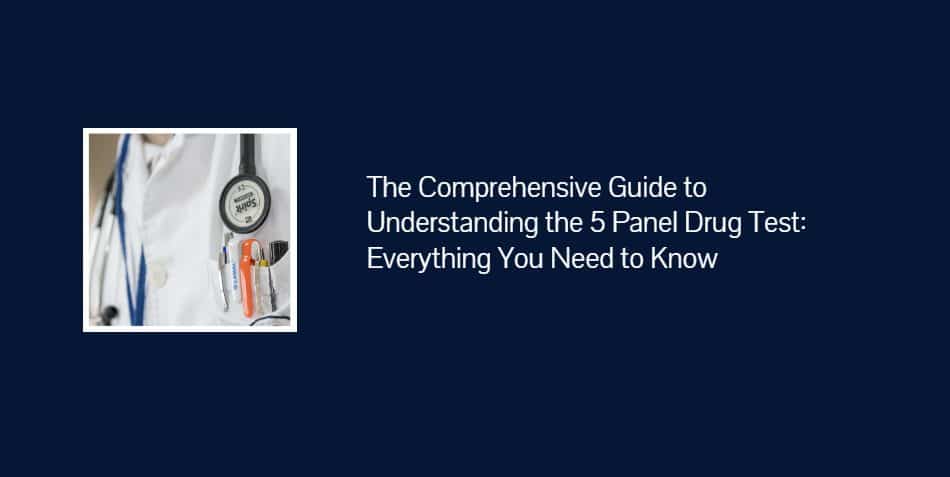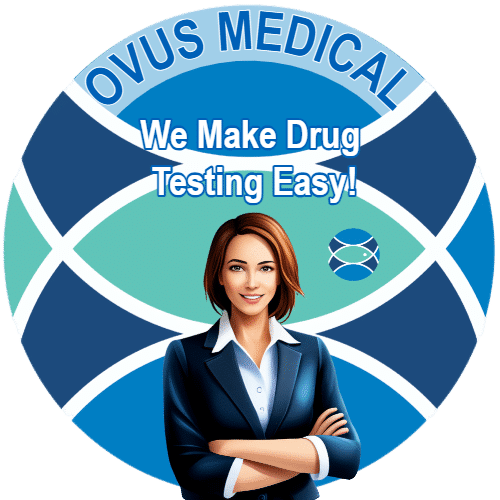The Comprehensive Guide to Understanding the 5-Panel Drug Test: Everything You Need to Know
A Guide to the 5-Panel Drug Test: Are you curious about the 5-panel drug test and what it entails? Look no further; this comprehensive guide has got you covered. Whether you’re an employer concerned about potential substance abuse among your employees or an individual preparing for a job interview, understanding the ins and outs of the 5-panel drug test is essential.
In this guide, we’ll dive deep into the specifics of this widely used drug screening method. We will explore the drugs detected, the testing process, and the common scenarios for their use. By the end, you’ll clearly understand what to expect if you ever encounter this type of drug test.
So, get ready to unravel the mysteries behind the A Guide to the 5 Panel Drug Test and equip yourself with the knowledge you need. Let’s dive in!

A Guide to the 5-Panel Drug Test
A 5-panel drug test is a commonly used method for screening potential drug use. It involves testing a urine sample for the presence of five different types of drugs. These drugs include marijuana (THC), cocaine, amphetamines, opiates, and phencyclidine (PCP). Each drug is included in the panel due to its prevalence and potential for abuse.
The 5-panel drug test is often conducted in various settings, including workplaces, schools, and rehabilitation centers. It provides valuable information about an individual’s recent drug use and can help identify potential substance abuse issues. Let’s take a closer look at why this type of drug test is so widely used.
Why are 5-panel drug tests commonly used?
There are several reasons why 5-panel drug tests are commonly used in different settings. First and foremost, these tests are cost-effective and relatively easy to administer. The panel of drugs tested covers some of the most commonly abused substances, making it an efficient screening tool.
For employers, implementing a 5-panel drug test as part of their hiring process helps ensure a safe and drug-free work environment. It can also help reduce absenteeism, accidents, and productivity issues associated with substance abuse. Additionally, schools may use these tests to detect and address drug use among students, promoting a healthy learning environment.
Rehabilitation centers also utilize 5-panel drug tests to monitor individuals in recovery and ensure compliance with sobriety programs. These tests can provide valuable information about an individual’s progress and help identify any potential relapses.
How does a 5-panel drug test work?
Now that we understand what a 5-panel drug test is and why it is commonly used, let’s explore how the testing process works. The process typically involves the following steps:
- Collection of a urine sample: The individual being tested is required to provide a urine sample in a designated collection cup. The sample is then sealed and labeled for identification purposes.
- Sample preservation: The collected urine sample is stored under controlled conditions to prevent tampering or contamination.
- Laboratory testing: The sealed urine sample is sent to a laboratory for analysis. Trained technicians use advanced testing methods to detect the presence or absence of the five drugs included in the panel.
- Results interpretation: The laboratory analyzes the sample and generates a detailed report indicating the presence or absence of each drug. These results are typically shared with the organization or individual requesting the test.
The entire process is designed to ensure accuracy and reliability in detecting drug use. Now that we have a clear understanding of the testing process, let’s explore the specific drugs that a 5-panel drug test is designed to detect.
Common drugs detected in a five-panel drug test
A 5-panel drug test is specifically designed to detect the presence of five commonly abused drugs. Let’s take a closer look at each drug and its effects:
- Marijuana (THC): Marijuana is a psychoactive drug derived from the cannabis plant. It is commonly used for recreational and medicinal purposes. The active ingredient in marijuana, THC, can impair cognitive function, coordination, and memory.
- Cocaine: Cocaine is a powerful stimulant derived from the coca plant. It produces intense feelings of euphoria and increased energy. Short-term effects of cocaine use include increased heart rate, elevated blood pressure, and heightened alertness.
- Amphetamines: Amphetamines are a class of stimulant drugs that are often prescribed for attention deficit hyperactivity disorder (ADHD) and narcolepsy. When used recreationally, amphetamines can cause increased energy, euphoria, and heightened focus.
- Opiates: Opiates, including heroin, morphine, and prescription painkillers, are highly addictive drugs derived from the opium poppy plant. They are known for their pain-relieving properties but can also cause drowsiness, respiratory depression, and a sense of euphoria.
- Phencyclidine (PCP): PCP, also known as angel dust, is a dissociative hallucinogenic drug. It can cause hallucinations, distorted perceptions of reality, and impaired motor function. PCP use can also lead to aggression and violent behavior.
These drugs are included in the 5-panel drug test due to their prevalence and potential for abuse. However, it’s important to note that this test does not detect the presence of other substances such as benzodiazepines, barbiturates, or synthetic cannabinoids.
Pros and cons of using a 5-panel drug test
Like any drug testing method, the 5-panel drug test has its own set of advantages and disadvantages. Let’s explore the pros and cons associated with this type of drug screening:
Pros of using a 5-panel drug test
- Cost-effective: Compared to more extensive drug testing panels, the 5-panel drug test is relatively affordable, making it a popular choice for many organizations and individuals.
- Easy to administer: The collection of urine samples is a straightforward process, making it easy to administer the test in various settings.
- Quick results: The turnaround time for obtaining results from a 5-panel drug test is relatively quick, allowing for timely decision-making.
Cons of using a 5-panel drug test
- Limited scope: The 5-panel drug test only detects the presence of five specific drugs. It may not provide a comprehensive picture of an individual’s substance use, especially if they are abusing substances not included in the panel.
- Detection window: The detection window for each drug can vary, and the 5-panel drug test may not detect drug use within a specific timeframe. For example, marijuana can be detected for days or weeks after use, while other drugs may only be detectable for a shorter period.
- False positives and negatives: Although rare, false-positive and false-negative results can occur with the 5-panel drug test. Factors such as medication use, metabolic variations, or laboratory errors can impact the accuracy of the results.
Understanding the pros and cons of the 5-panel drug test can help organizations and individuals make informed decisions about drug screening methods. Next, let’s explore how to prepare for a 5-panel drug test.
How to prepare for a 5-panel drug Test: A Guide to the 5-Panel Drug Test
If you’re scheduled to undergo a 5-panel drug test, it’s essential to be prepared. Here are some tips to ensure a smooth testing process:
- Familiarize yourself with the testing requirements: Understand the specific guidelines and instructions provided by the testing organization. This includes any dietary restrictions, medications to avoid, or specific protocols to follow before the test.
- Stay hydrated: Drinking plenty of water can help ensure an adequate urine sample during the test. However, avoid excessive water consumption, as it may dilute the urine and potentially raise suspicions of tampering.
- Avoid drug use: It goes without saying that abstaining from drug use before the test is crucial. Keep in mind that different drugs have varying detection windows, so it’s best to refrain from any substance use in the days leading up to the test.
- Follow proper sample collection procedures: When providing a urine sample, make sure to follow the designated collection procedures accurately. Failure to do so may result in an invalid sample, requiring a retest.
By following these preparation tips, you can increase the likelihood of obtaining accurate results from your 5-panel drug test. However, if you’re concerned about the possibility of a positive result, you may be wondering how to pass a 5-panel drug test. Let’s explore some important considerations.
How to pass a 5-panel drug test
While it’s important to note that attempting to cheat or manipulate a drug test is unethical and can have serious consequences, there are a few factors to consider if you’re concerned about a positive result on a 5-panel drug test:
- Detection windows: Familiarize yourself with the detection windows for each drug included in the panel. This will give you an idea of how long a specific substance may be detectable in your system.
- Timeframe: If you have recently used drugs and are concerned about a positive result, it’s crucial to understand the timeframe for which the drug may be detectable. This can help you plan accordingly and potentially reschedule the test if necessary.
- Consult a professional. If you have concerns or questions about passing a drug test, consider consulting a healthcare professional or substance abuse counselor. They can provide guidance and support based on your specific situation.
It’s important to remember that attempting to tamper with a drug test is both unethical and potentially illegal. Always approach drug tests with honesty and integrity, as the consequences of getting caught can severely impact your personal and professional lives.
Alternatives to 5-panel drug tests
While the 5-panel drug test is widely used, there are alternative drug testing methods available. These alternatives may offer different detection capabilities or focus on specific substances. Here are a few examples:
- 10 panel drug test: This test expands on the 5 panel drug test by including additional drugs such as benzodiazepines, barbiturates, methadone, and propoxyphene. It provides a more comprehensive evaluation of an individual’s drug use.
- Hair follicle drug test: Instead of testing urine, a hair follicle drug test analyzes a small sample of hair to detect the presence of drugs. This type of test can provide a longer detection window, typically up to 90 days.
- Saliva drug test: Saliva drug tests are non-invasive and can be administered on-site. They provide a quick screening method for recent drug use and are often used in workplaces or roadside testing.
Understanding the alternatives to the 5-panel drug test can help organizations and individuals choose the most appropriate testing method based on their specific needs and requirements.
Understanding false-positive and false-negative results
While 5-panel drug tests are generally accurate, it’s important to be aware of the possibility of false-positive and false-negative results. A false-positive result occurs when the test indicates the presence of a drug when none is actually present. Conversely, a false-negative result occurs when the test fails to detect the presence of a drug that is present.
Several factors can contribute to false-positive and false-negative results, including:
- Cross-reactivity: Some substances, such as certain medications or over-the-counter products, can produce false-positive results due to cross-reactivity with the drug test.
- Laboratory errors: Human error in the testing process can lead to inaccurate results. It’s important to ensure that the testing facility follows proper protocols and maintains high-quality standards.
- Metabolic variations: Individual variations in metabolism can impact the detection of drugs in urine samples. Factors such as age, weight, and overall health can affect the rate at which drugs are metabolized and excreted.
If you receive a positive result and believe it to be a false positive, it’s essential to consult with a healthcare professional or request a retest to confirm the result.
Conclusion
In conclusion, understanding the 5-panel drug test is crucial for employers, individuals, and organizations involved in drug screening. This comprehensive guide has provided insights into the purpose, process, and significance of the 5-panel drug test.
We explored the types of drugs detected by this test, the pros and cons associated with its use, and how to prepare for and potentially pass a 5-panel drug test. Additionally, we discussed alternative drug testing methods and the possibility of false-positive and false-negative results.
By equipping yourself with knowledge about the 5-panel drug test, you can make informed decisions regarding drug screening and promote a safer, drug-free environment. Remember, the goal is not only to detect drug use but also to support individuals in overcoming substance abuse and fostering personal and professional growth.



